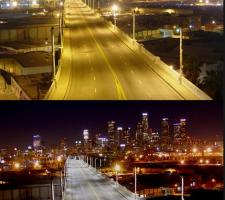
The need to connect existing infrastructure has led various US transit authorities into imaginative alleyways: David Crawford examines some new roles for street furniture.
US cities are vying with each other in developing schemes to create a new generation of connected places. Their strategies include taking advantage of their streetlight poles’ height and ubiquity to give them new roles in supporting intelligent nodes. They are now being equipped for collecting real-time data on key transport-linked factors such as air quality and vehicle and pedestrian usage of public roads, for analysis for environmental monitoring, improved safety and infrastructural planning. Pittsburgh, the second largest city in Pennsylvania, suffers from one of the US’ highest air pollution levels, and was one of seven finalists (and the smallest by some way) in the US Department for Transportation’s (USDOT) Smart City Challenge. Launched in December 2015, this attracted funding applications from 78 medium-sized municipalities that were keen to boost their urban intelligence ratings.
Pittsburgh didn’t win the $50 million jackpot. But mayor Bill Peduto’s emphasis on creating an open platform, to support new travel options for underserved neighbourhoods, won important publicity and offers of alternative funding. His vision is twofold. Firstly, conversion of up to 36,000 streetlight lamps on over 3,200 lane/km of public roadways to LED lamps reduces energy use and maintenance costs – a more ambitious target than in other cities’ bids. Second, smartening up the poles by equipping them with sensors makes them integral parts of connected data networks. The move followed a 2012 initiative, funded by the state of Pennsylvania DOT, that piloted 4,500 upgrades. The savings that this generated set the scene for an open-style quest for proposals for wide-scale smartening. Pittsburgh is now actively exploring the potential for using the resulting sensor infrastructure for further applications, including a mesh network of public Wi-Fi, which would help give more people access to modern communications technology. Collaboration with mobile phone operators to install low-power ‘stations’ (femtocells) on streetlight poles could substantially expand the city’s current cellular network infrastructure and help meet increased demand for mobile data.
Sensor results
The results collected from sensors could then be made available for public access as an extension of a regional open data platform covering the western area of Pennsylvania which centres on Pittsburgh. The city says that it has already carried out much of the necessary groundwork. In a parallel initiative, it became the beneficiary, in 2016, of a $10.9 million grant, made under USDOT’s Fixing America’s Surface Transportation (FAST) Act, to develop its ‘smart spines’ concept. This involves deploying networks of streetlight-mounted sensors specifically along the city’s five most heavily-travelled road corridors, that connect its most densely populated areas to the Downtown and Oakland employment hubs, which are among the largest in Pennsylvania. Specifically, the sensor-derived data can integrate with the operation of the city’s Scalable Urban Traffic Control (Surtrac) programme. Developed at Pittsburgh’s Carnegie Mellon University to handle constantly changing traffic patterns through a cluster of major junctions that were proving too complex for conventional signals to manage adequately, this has reduced average travel times by 25%.
Traffic surges
Where the system has needed reinforcement, however, is in the event of traffic surges arising in between Surtrac-controlled intersections. For example, cars exiting from a parking garage after an event such as a concert in an intermediate location will impact on the situation at the intersection towards which they’re heading. Strategically placed sensors can record the origin and destination characteristics of the resulting rushes - which Surtrac, on its own, is unable to predict - and communicate the necessary information to the relevant traffic controllers. The key issue throughout is the optimisation of existing road space. City department of mobility and infrastructure director Karina Ricks told ITS International: “There are very few opportunities to widen roads within Pittsburgh. Even if we could, that just means we’re using up valuable real estate where we could be building businesses or housing or creating parkland.” Brought in by Peduto, Ricks is the first holder of her post, having previously worked for the Washington DC DOT and as a founding principal of US transportation consultant Nelson/Nygaard. Again, most of the city’s public housing is clustered along the five strategic corridors. Optimising the performance of bus transit by applying more effective overall traffic management, via adaptive signals, will give residents more regular and reliable access to the jobs. The result of this activity is that Pittsburgh is on its way towards becoming a living test bed for modern advances in large-scale smart signal technology. The city and Pennsylvania DOT have partnered in a $30 million bid to create what they believe will be the largest operational adaptive array in the US, with signals and smart streetlights constantly exchanging data.
San Diego’s buffet
In California, the city of San Diego is rolling out a programme to equip 3200 streetlight poles with what deputy chief operating officer David Graham described at a November 2017 launch event as a “buffet” of sensors. By the end of 2018, the array is due to cover around 50% of the urban area. Each of the nodes, designed and operated by General Electric energy management subsidiary Current, as part of its CityIQ initiative, will cover an oval area of approximately 54m by 36m and automatically register environmental conditions such as air temperature, humidity and pollution. One immediate additional application will be in on-street parking management, detecting vacant bays and advising drivers of their availability; and, later on, alerting enforcement officers to cases of illegal parking. Another role could involve more detailed monitoring of what is happening at city centre intersections. The nodes could record when traffic is backing up along the approach roads and enable the retiming of traffic signals to reflect actual flows. They could also pick up sounds - ranging from those of broken glass, that could indicate a minor incident, to those of a full-scale crash - and automatically alert police in accordance with the likely severity of the event.
Greater safety
Again, the system could determine more accurately which are the most dangerous intersections for both drivers and pedestrians, by logging near misses to supplement official data on accidents that actually happen. The results would enable greater safety through more informed roadway redesigns, that would also offer the best value for money in the shape of long-term benefits. In a wider context, the city intends to make publicly available the data it gathers, for example to software developers for app creating. The way forward for these has already been paved via a series of hackathons. Ideas that have emerged to date include tracking pedestrian movements to identity potential clusters that could have safety implications; directing individual pedestrians to the quietest walking routes; and shepherding truck drivers to available and convenient parking slots. San Diego expects to recoup much of the cost of its IoT (Internet of Things) programme over a 13-year span from the savings resulting from switching its streetlights to brightness-adjustable LEDs. Other US cities lining up for the CityIQ treatment include Atlanta, Georgia.
Lighting up La La Land
The Los Angeles Bureau of Street Lighting, which manages some 215,000 poles, has installed a pilot ‘smart node’ on Wilshire Boulevard near the La Brea Tar Pits, an ice age fossil excavation site that has become a popular visitor attraction. Its city centre location is enabling realistic trials of its capability to respond to, and support, a range of urban and pedestrian traffic needs and situations. Designed to resemble a typical streetlight, it aims to exemplify what bureau director Ed Ebrahimian sees as growing roles for existing poles as “valuable and productive infrastructural assets”. LA’s prototype incorporates a top-mounted warning beacon that can flash in a range of colours; cellphone antennae; Wi-Fi capability; loud speakers to broadcast music or announcements; video surveillance cameras; electric vehicle charging ports; and mobile phone charging ports as well as a standard 110-volt outlet. Its performance will help decide the scope for, and type of, wider deployment – though potential costs have yet to be explored in detail. Future testing, said Ebrahimian. “could also involve plugging in any number of sensors, popular among city technology officials today”. He concluded: “We could have temperature and CO2 monitoring. We could have traffic volume information. There’s not a limit.”







